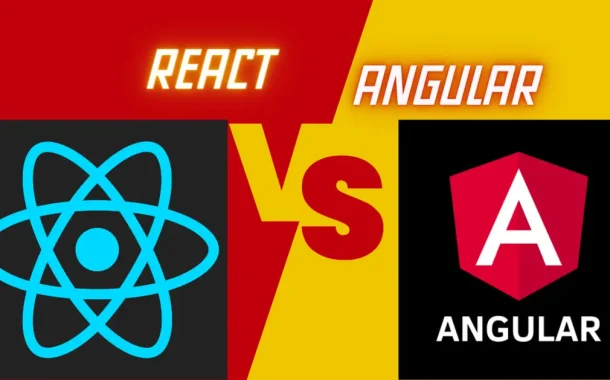Angular is good for making big websites with many features, like forms and menus. React is simpler and more flexible, but Angular has more built-in features. Both are popular and used by many big companies to make websites and apps. It’s like choosing between building something with Legos (React) or using a whole construction kit (Angular).
Table of Contents
Table of Contents
React
React works by breaking down your website or application into small, reusable components. Imagine each component as a LEGO brick that you can use to build different parts of your site, like buttons, forms, or menus.
When something changes in your application, React smartly updates only the parts of the interface that need to change, instead of refreshing the entire page. This is possible because React uses a virtual DOM (Document Object Model), which is like a lightweight copy of the real DOM. React compares the virtual DOM with the actual DOM to figure out what changed, then only updates the specific elements that need it.
To write code in React, you use JSX, a special syntax that mixes JavaScript with HTML-like elements. It looks like HTML. But it’s JavaScript under the hood, making it easy to write and understand UI components.
React also helps manage the state of your application, which means keeping track of data and user interactions. This makes it easier to create dynamic and interactive experiences for your users. Overall, React simplifies the process of building modern web applications by promoting a component-based architecture and efficient updating of the user interface.

Angular
Angular works by providing a comprehensive framework for building web applications using TypeScript, a superset of JavaScript. It follows the MVC (Model-View-Controller) architecture, where the application logic, user interface, and data model are separated into distinct components.
In Angular, you create components to represent different parts of your application’s user interface, such as headers, footers, and content areas. These components encapsulate both the HTML layout and the associated logic, making it easier to manage and reuse code.
Angular uses two-way data binding, which means changes to the application state automatically reflect in the user interface, and vice versa. This simplifies the process of handling user input and updating the UI accordingly.
The framework also includes features like dependency injection, which allows components to be easily managed and tested independently. Angular’s built-in router enables navigation between different views within the application, providing a seamless user experience.
Overall, Angular streamlines web development by providing a structured framework with powerful features for building dynamic and interactive web applications. It promotes modularity, maintainability, and scalability, making it suitable for both small projects and large-scale enterprise applications.

Architectural Differences
These differences help you choose the right framework for your project.
Component-Based Architecture
- React: Your website is made up of building blocks called components, which you can reuse and combine.
- Angular: Works similarly with components but includes more features like services and directives.
Data Binding
- React: Data moves in one direction, making it clear where changes come from.
- Angular: Offers both one-way, where changes move from parent to child, and two-way data binding, where changes in the UI also update the data.
State Management
- React: You can pick from different tools to manage how your app stores and handles data changes.
- Angular: Comes with built-in tools like services and observables to handle data and state across your app.
Routing
- React: Needs extra libraries like React Router for handling page navigation.
- Angular: Has a built-in router that helps you define different pages and navigate between them.
Performance
- React: Keeps your website fast by using a virtual copy of the page that updates only what needs changing.
- Angular: Its change detection system helps manage updates, but too much data binding can slow things down.
Language and Tooling Support
Language and Tooling Support refers to the programming languages used and the tools available for development.
Programming Languages
- React: Primarily uses JavaScript, including JSX syntax for combining JavaScript with HTML-like elements.
- Angular: Uses TypeScript, a superset of JavaScript that adds static typing and other features to the language.
Developer Tooling and Ecosystem
- React: Offers a rich ecosystem of tools and libraries, including popular ones like React DevTools and Create React App for scaffolding projects.
- Angular: Provides a comprehensive set of tools, including Angular CLI for project scaffolding, debugging tools, and a wide range of official and community-supported libraries.
Learning Curve
- React: Generally has a lower entry barrier, especially for developers familiar with JavaScript. Learning JSX might take some getting used to, but the overall learning curve is relatively gentle.
- Angular: This can have a steeper learning curve, particularly for developers new to TypeScript and the Angular framework’s conventions. However, Angular’s opinionated structure can also provide clarity and consistency once mastered.
Community and Support
React and Angular have robust community support, ensuring that developers have access to resources, assistance, and updates to keep their projects running smoothly.
Size and Activity
- React: Boasts a large and active community, with a vast number of developers contributing to its growth. It’s supported by Facebook and has a thriving ecosystem of third-party libraries and resources.
- Angular: Also has a sizable community, backed by Google, which actively maintains and supports the framework. It has dedicated forums, mailing lists, and online communities where developers can seek help and share knowledge.
Documentation and Resources
- React: Offers comprehensive documentation, tutorials, and guides, maintained by Facebook and the community. Additionally, there are numerous online resources, blogs, and video tutorials available for learning React.
- Angular: Provides extensive documentation, including guides, tutorials, and API references, maintained by the Angular team. The official documentation is supplemented by a wealth of community-contributed resources and tutorials.
Community Support and Contributions
- React: Benefits from a vibrant community that actively contributes to the development of libraries, tools, and best practices. The React ecosystem is rich with open-source projects and community-driven initiatives.
- Angular: Similarly, enjoys strong community support, with developers contributing to the framework’s development, creating extensions, and providing assistance on forums and social media platforms.
Considerations for Scalability and Performance
Scalability Considerations
- React: React’s strength lies in its flexibility, allowing developers to grow their applications organically by breaking them down into reusable components. These components can be easily managed and scaled independently, facilitating the maintenance of large codebases.
- Angular: Angular offers a more structured approach to scalability, providing built-in features such as modules, services, and dependency injection. These features promote modularity and maintainability, making it easier to manage and scale complex applications as they grow.
Performance Benchmarks
- React: React is known for its efficient rendering mechanism using a virtual DOM. By minimizing DOM updates and only rendering components that have changed, React ensures fast and responsive user interfaces. This lightweight approach to updating the UI makes React well-suited for applications with frequent UI updates.
- Angular: Angular’s performance is bolstered by its robust change detection mechanism. However, the bidirectional data binding feature of Angular can lead to performance issues in applications with extensive data updates. Despite this, Angular offers optimization features like ahead-of-time (AOT) compilation and tree-shaking to improve performance.
Handling Large-Scale Applications
- React: React is widely used for building large-scale applications due to its flexibility and extensive ecosystem of tools and libraries. Developers have the freedom to choose state management solutions and optimize performance based on the specific requirements of their projects.
- Angular: Angular is designed with enterprise-level scalability in mind, providing a comprehensive solution for building complex applications. Its opinionated structure promotes consistency and maintainability, facilitating collaboration among large development teams.
Ecosystem and Libraries
Ecosystems and libraries are essential factors to consider when evaluating React and Angular.
Third-Party Libraries and Plugins
- React: Offers many extra tools you can add to your project, like Redux for managing data or React Router for navigation.
- Angular: Also has a bunch of extra tools available, such as NgRx for data management and Angular Router for navigation.
Integration with Other Technologies
- React: Works well with other tools and technologies, like Redux for data and GraphQL for fetching data from servers.
- Angular: Fits nicely with different technologies too, such as RxJS for reactive programming and TypeScript for writing cleaner code.
Available Resources and Extensions
- React: You’ll find lots of helpful guides, tutorials, and tools like Create React App to kickstart your project.
- Angular: Offers plenty of resources too, including guides, tutorials, and Angular CLI for project setup. Debugging tools like Augury can also help you find and fix issues in your Angular apps.
Conclusion
React is great for creating flexible user interfaces, thanks to its component-based approach. It’s lightweight and efficient, making it perfect for applications that require frequent updates. With a vast community and plenty of third-party tools, React offers endless possibilities for customization.
Angular, on the other hand, provides a comprehensive solution for building large-scale applications. Its structured approach and built-in features like dependency injection make it ideal for enterprise-level projects. Angular’s extensive documentation and tooling support streamline development and maintenance processes.
Ultimately, the choice between React and Angular depends on project requirements and team preferences. React suits those who value flexibility and simplicity, while Angular appeals to developers seeking a robust and opinionated framework.














